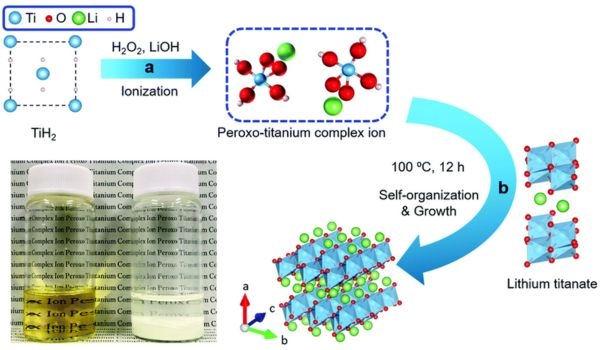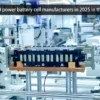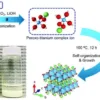Are you curious about the latest breakthroughs in lithium titanate battery technology? Finding a fast-charging, safe, and long-lasting energy storage solution can transform industries like EVs and renewable energy.
As a battery tech enthusiast, I’ve seen how LTO batteries stand out for their incredible performance and durability. This isn’t just another battery trend—it’s a game-changer.
In this article, you’ll discover the current state of LTO battery technology, its real-world applications, and why it’s shaping the future of energy storage.
Let’s dive in!
What Are Lithium Titanate LTO Batteries
Definition and Chemistry of Lithium Titanate Batteries
Lithium Titanate (LTO) batteries are a type of rechargeable lithium-ion battery that use lithium titanate oxide (Li4Ti5O12) as the anode material instead of the traditional graphite. This unique chemistry allows LTO batteries to charge and discharge much faster, with a higher degree of safety and durability. The lithium titanate anode provides a stable crystal structure, which significantly reduces the risk of dendrite formation—a common cause of short circuits in conventional lithium-ion batteries.
Key Features of LTO Battery Technology
LTO batteries stand out for several critical features, including:
- Ultra-fast charging capabilities: LTO batteries can reach a full charge in as little as 10 to 15 minutes, making them ideal for high-demand applications.
- Exceptional battery cycle life: LTO cells can typically maintain over 7,000 to 10,000 charge cycles, far exceeding the lifespan of traditional lithium-ion batteries.
- Superior battery safety features: Their stability minimizes overheating and thermal runaway risks.
- Wide operational temperature range: LTO batteries function reliably in temperatures from -30°C to 55°C, outperforming many lithium-ion alternatives.
- High power output: These batteries are designed for high-current applications, providing rapid energy delivery when needed.
Comparison with Other Battery Technologies
When comparing lithium titanate batteries with other energy storage solutions such as standard lithium-ion or nickel-metal hydride batteries, a few key distinctions emerge:
| Feature | Lithium Titanate Battery | Traditional Lithium-ion Battery | Nickel-Metal Hydride (NiMH) |
|---|---|---|---|
| Charging Speed | Extremely fast (minutes) | Moderate (hours) | Slow |
| Cycle Life | 7,000–10,000 cycles | 500–1,000 cycles | 300–500 cycles |
| Energy Density | Lower (60–110 Wh/kg) | Higher (150–250 Wh/kg) | Lower (60–120 Wh/kg) |
| Temperature Range | -30°C to 55°C | 0°C to 45°C | 0°C to 50°C |
| Safety | High stability, low risk | Moderate risk of thermal runaway | Moderate safety |
Despite having a lower energy density, the robustness and longevity of LTO batteries make them especially suited for fast-charging battery solutions and high-power applications requiring extreme reliability.
Understanding what sets LTO batteries apart is essential for recognizing their growing value in sectors like electric vehicle batteries, renewable energy storage, and advanced industrial uses. Their unique chemistry and performance features offer a compelling alternative where endurance, speed, and safety matter most.
Current Advancements in Lithium Titanate LTO Battery Technology

Lithium titanate battery technology is evolving quickly, driven by demand for better performance and wider adoption. Here’s a closer look at the key advancements shaping this space.
Performance Improvements
One major focus has been on boosting the performance of LTO batteries without sacrificing their core strengths:
- Faster charging times: New LTO chemistries and electrode structures enable charging in minutes, making them stand out among fast-charging batteries.
- Extended cycle life: Research is pushing battery cycle life even further, sometimes beyond 10,000 cycles, enhancing LTO’s reputation for longevity.
- Better temperature tolerance: Improved thermal stability means these batteries work reliably in extreme temperatures, perfect for electric vehicles and industrial use.
- Higher energy efficiency: Ongoing tweaks are reducing internal resistance, giving users more usable power per charge.
Manufacturing Innovations
Manufacturers are refining production techniques to improve quality and reduce costs:
- Advanced coating and mixing processes are increasing electrode consistency.
- Automation and robotics help scale production while maintaining precision, crucial for meeting growing US market demands.
- Use of sustainable materials and eco-friendly processes is also gaining traction to align with environmental goals.
These innovations help make LTO batteries more competitively priced against traditional lithium-ion options.
Key Industry Players and Collaborations
The LTO market has seen active participation from established and emerging companies:
- Big names like Toshiba and Panasonic continue to invest in R&D, improving LTO cell chemistry.
- Startups and smaller firms are partnering with automotive and energy companies to customize solutions.
- Collaborations often focus on integrating LTO batteries into electric vehicles (EVs), renewable energy storage, and heavy-duty applications.
These partnerships accelerate the adoption of LTO in proven, real-world scenarios.
Recent Applications and Use Cases
LTO batteries are finding their way into more sophisticated uses, thanks to these upgrades:
- Electric vehicle batteries benefit from quick charge and long life, aligning with the push for fast turnaround times.
- Deployment in renewable energy storage systems for grid stability and peak shaving.
- Expanded use in medical devices and consumer electronics where rapid charging and safety are critical.
- Growing interest in high-power industrial and aerospace applications, which demand robustness and reliability.
For those exploring battery options or upgrading existing systems, understanding these current trends can be crucial. You can find more practical insights about lithium battery installations and safety at li-ess install lithium battery in golf cart.
Overall, advances in LTO battery technology are making these batteries more efficient, accessible, and suited for a wider range of industries — especially here in the US where durability and fast charging are big selling points.
Applications Driving Lithium Titanate LTO Battery Adoption
Lithium titanate (LTO) batteries are increasingly gaining traction across diverse sectors in the United States, thanks to their unique strengths in fast charging, durability, and safety. Here’s a clear look at where LTO battery technology is making a real difference:
Electric Vehicles EVs
- Fast charging capability: LTO batteries can charge much quicker than traditional lithium-ion batteries, which is a major plus for EV owners who want to minimize downtime.
- Long cycle life: They handle thousands of charge cycles without significant degradation, perfect for EVs running daily routes or fleets.
- Safety advantages: Enhanced thermal stability reduces risks of overheating, critical for electric vehicle safety, especially as demand for EVs rises nationally.
Renewable Energy Storage
- Reliable energy buffering: LTO batteries support smooth energy flow in solar and wind setups by providing quick charge and discharge cycles.
- Grid stability: Their robustness and fast response help balance energy loads, making renewable systems more dependable.
- Durability: LTO batteries endure extreme environments and frequent cycling, key for large-scale and off-grid renewable applications.
Consumer Electronics and Medical Devices
- Long-lasting power: For devices that need reliable operation over extended periods, like medical monitors and wearable tech, LTO batteries offer consistent performance.
- Fast recharge: Quick charging reduces downtime for critical devices, enhancing usability in healthcare settings.
- Safety: Reduced fire risk is vital in both consumer and medical tech, where device reliability and user safety can’t be compromised.
Industrial and Aerospace Applications
- High-power demands: Industrial machinery and aerospace systems benefit from LTO’s ability to deliver high current bursts without stress, useful in heavy-duty equipment and flight control systems.
- Extreme temperature tolerance: LTO batteries maintain performance in harsh temperature zones common in aerospace and demanding industrial sites.
- Longevity: The extended cycle life reduces maintenance frequency and downtime, helping U.S. industries save on operational costs.
Why LTO Matters for the US Market
In the U.S., where energy storage solutions and electric vehicle batteries are booming sectors, LTO battery technology stands out for its safety and reliability. As consumers and businesses seek fast-charging, long-life, and safe battery options, LTO batteries perfectly address these needs, making them a strong contender amid rapid technological shifts.
With ongoing improvements and broader adoption in these key areas, lithium titanate batteries are carving out a valuable role in America’s energy and mobility future.
Challenges Facing Lithium Titanate Battery Technology
Even though lithium titanate battery (LTO) technology offers many benefits like fast charging and long cycle life, it still faces some clear challenges holding back wider adoption in the U.S. market and beyond.
Lower Energy Density Compared to Other Lithium-ion Batteries
One of the biggest limitations of LTO batteries is their lower energy density. Compared to traditional lithium-ion batteries, LTO cells store less energy in the same size or weight. That means:
- Larger or heavier packs are needed for the same range in electric vehicles (EVs).
- Less storage capacity per unit volume or weight in renewable energy systems.
This makes LTO less competitive where space and weight are critical, such as in consumer electronics or passenger EVs.
High Production Costs Impacting Market Competitiveness
Manufacturing LTO battery technology is generally more expensive than other lithium-ion chemistries. The reasons include:
- Specialized materials and complex electrode preparation.
- Limited production scale compared to more common lithium-ion batteries.
These higher costs translate to pricier battery packs, which can be a barrier for affordability in price-sensitive sectors like consumer EVs and home energy storage.
Limited Market Awareness and Adoption
Many U.S. consumers and even businesses remain unfamiliar with lithium titanate batteries. The technology is often overshadowed by more mainstream lithium-ion types such as NMC or LFP. This lack of awareness means:
- Less demand driving economies of scale.
- Fewer partnerships or investments focused on LTO improvements.
For companies and end-users, the unfamiliarity also translates to uncertainty about performance, safety, and true lifecycle benefits.
Competition from Emerging Battery Technologies
The energy storage market is evolving fast, and LTO battery technology faces stiff competition from several emerging alternatives, including:
- Solid-state batteries promising higher energy density and safety.
- Advanced lithium-ion chemistries like nickel-rich cathodes focusing on cost and energy gains.
- Sodium-ion and other post-lithium technologies aiming for resource sustainability.
These developments put pressure on LTO to innovate further to stay relevant, especially in high-growth sectors like electric vehicles and grid energy storage.
lower energy density, high costs, limited market awareness, and rising competition are the key challenges for lithium titanate battery technology. Overcoming these hurdles is crucial for expanding LTO’s role in the U.S. energy and transportation sectors.
Market Trends and Future Prospects for Lithium Titanate Battery Technology
Lithium titanate (LTO) battery technology is gaining steady momentum in the U.S. market, fueled by growing demand for fast-charging batteries and reliable energy storage solutions. Here’s a closer look at what’s driving its growth and where it’s heading.
Strong Market Growth and Expanding Applications
The LTO battery market is expanding, thanks largely to its unique advantages in battery cycle life and battery safety features. More industries—especially electric vehicle batteries and renewable energy storage—are turning to LTO for applications that need quick charging and long-lasting performance. This demand is driving manufacturers to scale up production.
- Electric vehicle market: LTO batteries are being used more frequently where rapid charging and durability are key.
- Grid-scale energy storage: Utilities are tapping into LTO tech to smooth out renewable energy supply.
- Specialty sectors: Medical devices and aerospace are also exploring LTO for high-power and safety-critical needs.
Cost Reduction Efforts
While LTO batteries have a reputation for higher upfront costs than traditional lithium-ion batteries, companies in the U.S. are making solid strides to lower production expenses by:
- Streamlining manufacturing processes
- Using less expensive raw materials where possible
- Increasing automation and scale to boost efficiency
These efforts are making LTO batteries more accessible for mass-market applications without compromising quality.
Sustainability and Supply Chain Improvements
Sustainability is a big focus in the battery industry, and LTO batteries have some advantages:
- LTO chemistry reduces the need for cobalt, which lessens ethical and environmental concerns.
- Their long lifespan means fewer replacements and less waste.
- Efforts are underway to secure domestic sources of key materials to avoid supply chain disruptions.
These factors align well with U.S. customers and businesses prioritizing clean energy and responsible sourcing.
Emerging Applications and Role of Lithium Energy Storage Systems
Beyond traditional uses, new opportunities are emerging for LTO batteries in:
- Microgrids and backup power solutions
- Fast-charging consumer electronics
- Industrial equipment needing high-power bursts
Lithium titanate batteries play an important role in the broader lithium energy storage systems (li-ess) landscape, where their fast charging and high cycle life complement other lithium-ion technologies to create versatile, scalable solutions.
In , the future of LTO battery technology in the U.S. looks promising. Continued market growth, cost reduction, sustainability focus, and expanding applications are all paving the way for LTO batteries to become a key player in America’s energy and transportation sectors.









Add comment